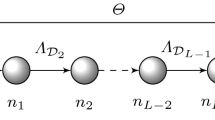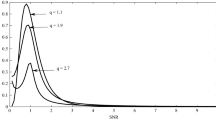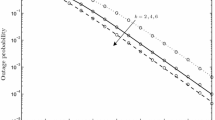Abstract
In this paper, a general small-scale fading model for wireless communications, that explores the nonlinearity and at the same time the inhomogeneous nature of the propagation medium, is presented, studied in terms of its first-order statistics of the envelope, and validated by means of field measurements and the Monte Carlo simulation. It is indeed a novel distribution with many advantages such as its generality, its physical interpretation that is directly associated with the propagation channel, and its mathematical tractability due to its simple and closed-form expression. By fitting to measurement data, it has been shown that the proposed distribution outperforms the widely known fading distributions. Namely, the α − λ − μ model, which can be in fact called α − η − μ format 2 model, can also be obtained from the α − η − μ format 1 model by a rotation of the axes. Both formats are combined, in order to result to a unified model in a closed form that may describe the propagation environment in a variety of different fading conditions. Its physical background is hidden behind the names of its parameters. The unified model includes the already known general distributions α − μ′, η − μ, λ − μ (η − μ format 2), and their inclusive ones as special cases.
Similar content being viewed by others
References
Hoyt R. S. (1947) Probability functions for the modulus and angle of the normal complex variate. Bell System Technical Journal 26: 318–359
Nakagami M. (1960) The m-distribution–a general formula of intensity distribution of rapid fading. In: Hoffman W. C. (eds) Statistical methods in radio wave propagation. Pergamon, Elmsford, NY
Weibull W. (1951) A statistical distribution function of wide applicability. Journal of Applied Mechanics 27: 292–297
Abdi A., Lau W. C., Alouini M.-S., Kaveh M. (2003) A new simple model for land mobile satellite channels: First and second order statistics. IEEE Transactions on Wireless Communications 2(3): 519–528
Fraidenraich, G., & Yacoub, M. D. (2003). The λ − μ general fading distribution. In IEEE microwave and optoelectronics Conference, IMOC 2003. Proceedings of the SBMO/IEEE MTT-S international (Vol. 1, pp. 49–54).
Braun W. R., Dersch U. (1991) A physical mobile radio channel model. IEEE Transactions on Vehicular Technology 40(2): 27–34
Yacoub M. D. (2007) The α −μ distribution: A physical fading model for the stacy distribution. IEEE Transactions on Vehicular Technology 56(1): 27–34
Stacy E. W. (1962) A generalization of the gamma distribution. The Annals of Mathematical Statistics 33(3): 1187–1192
Sagias N. C., Mathiopoulos P. T. (2005) Switched diversity receivers over generalized gamma fading channels. IEEE Communications Letters 9(10): 871–873
Yacoub M. D. (2007) The η − μ and the η − κ distribution. IEEE Antennas Propagation Magazine 49(1): 68–81
Yacoub, M. D., & Fraidenraich, G. (2006). The α − η − μ and α − κ − μ fading distributions. In IEEE ninth international symposium on spread spectrum techniques and applications (pp. 16–20).
Abramowitz M., Stegun I. A. (Eds) (1972) Handbook of mathematical functions with formulas, graphs, and mathematical tables. NewYork, Dover.
Asplund, H., Molisch, A. F., Steinbauer, M., & Mehta, N. B. (2002). Clustering of scatterers in mobile radio channels—evaluation and modeling in the COST259 directional channel model. In IEEE international conference on communications, ICC 2002, New York.
Butterworth, J. S., & Matt, E. E. (1983). The characterization of propagation effects for land mobile satellite services. In International conference on satellite systems for mobile communication and navigations (pp. 51–54).
Abouraddy A. F., Elnoubi S. M. (2000) Statistical modeling of the indoor radio channel at 10 GHz through propagation measurements—part I: Narrow-band measurements and modeling. IEEE Transactions on Vehicular Technology 49(5): 1491–1507
Smith, H., Barton, S. K., Gardiner, J. G., & Sforza, M. (1992). Characterization of the land mobile-satellite (LMS) channel at L and S bands: Narrowband measurements. Bradford, ESA AOPs 104 433/114 473.
Jakes W. C. (1974) Microwave mobile communications. Wiley, New York
Author information
Authors and Affiliations
Corresponding author
Rights and permissions
About this article
Cite this article
Papazafeiropoulos, A.K., Kotsopoulos, S.A. The α − λ − μ and α − η − μ Small-Scale General Fading Distributions: A Unified Approach. Wireless Pers Commun 57, 735–751 (2011). https://doi.org/10.1007/s11277-009-9874-1
Published:
Issue Date:
DOI: https://doi.org/10.1007/s11277-009-9874-1




